To those of us that love beer, the temperature it is served at is important. The colder it is the more refreshing it is, and no one likes a warm beer. Having a dedicated beer fridge is the best scenario for storing that liquid gold. However, what is the best temperature to set it at? And more importantly, do I need a thermometer for my beer fridge?
Beer temperature is more important than most people think, especially with the surge in popularity of craft beer. As a home bar owner, it is important to serve your beer at the right temperature. The way the brewer intended for maximum enjoyment.
Do I Need A Thermometer For My Beer Fridge?
The simple answer is yes, a thermometer would be a great addition to your home bar tools. Getting the temperature right for the type of beer you are serving is important. Too cold and you will mask aromas and flavors, killing the essence of a good beer. A thermometer will help to regulate the temperature of your fridge to the type of beer you store in it.
It’s the best way to get the best out of your beer.
What Temperature Should My Beer Fridge Be At?
Now we know the importance of beer temperature. It therefore makes sense to use a thermometer to get the fridge to around the right temperature. But what temperature is the right temperature?
It depends on what beer you like to drink. Not all beers are equal when it comes to the level of coldness they are served at. Therefore it takes a little thought to get things right in the beer fridge department. A mass produced lager is better served cold, on the other hand a stout deserves a little warmth.
How then can I get the fridge temperature right, if I like different styles of beer?
Good Question, and there is not one set answer. But before we deal with that, lets take a look at the best temperatures for different beers.
Optimal Beer Temperatures
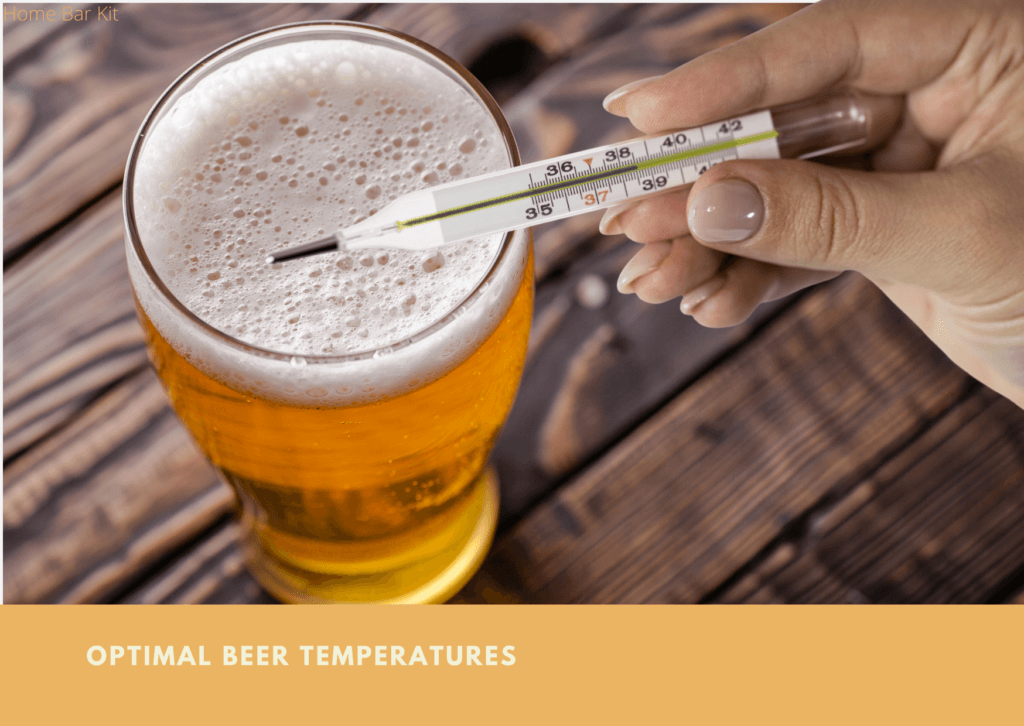
To get the best out of the beer you are drinking serve it at the right temperature. We don’t have to be too pedantic here, but getting it close will enhance the experience. We all love a cold beer, especially on a warm evening after a hard days graft. But not all beers benefit from a chilly atmosphere, they prefer a slightly warmer environment.
Starting at the cold end of the scale, I will work up to the more complex flavored warm end of the scale.
Macro Beers
Those mass produced beers, also known as macro beers prefer to be ice cold. The likes of lagers, such as Coors or Carling are the beasts we are talking about. They are not big on aroma of flavor, so a cold disposition suits them. It makes them refreshing, its what they live for, they exist to refresh and satisfy.
A perfect temperature for these beers is around 38°F (3.3°C). The perfect range is 36°F (2.2°C) to 40°F (4.4°C). A standard draft beer system is within this range and serves these beers for optimal enjoyment.
If your bag is all about the macros, then cold is best.
Pilsners And Full Body Lagers
The stronger lagers with a fuller body are better served slightly warmer than their macro cousins. These include wheat beers too, like a Berliner Weisse. Brewed more for flavor than quantity, if they are served too cold can mask those flavors.
Consequently it is better to store these beers at a higher temperature. Ideally between 40°F (4.4°C) to 45°F (7.2°C). This range of temperature will suit these more full bodied beers.
Pale Ales And IPA’S
We are edging into more fuller flavors and hoppy notes, which deserve a warmer reception. Serve these too cold and you are cloaking the palate and missing out. I have found the hoppier the beer, serves better at the warmer end of the scale.
A decent range is between 45°F (7.2°C) to 50°F (10°C). I prefer the higher end of this range, and slightly higher still works for a crafty IPA.
Real Ales And Porters
The heavy weights of the beer world, these full flavor titans with their complex flavors and strength don’t like the cold. On the other hand, room temperature would be too warm, for me anyway. Slightly chilled is best, between 50°F (10°C) and 60°F (15.5°C).
To allow the complex flavors to stroke the palate these beers are better served warm. As a personal choice, I prefer the warmer end of the scale.
These temperatures are only a guidelines and based on my experience with trying beers at different levels.
Best Beer Fridge Temperature
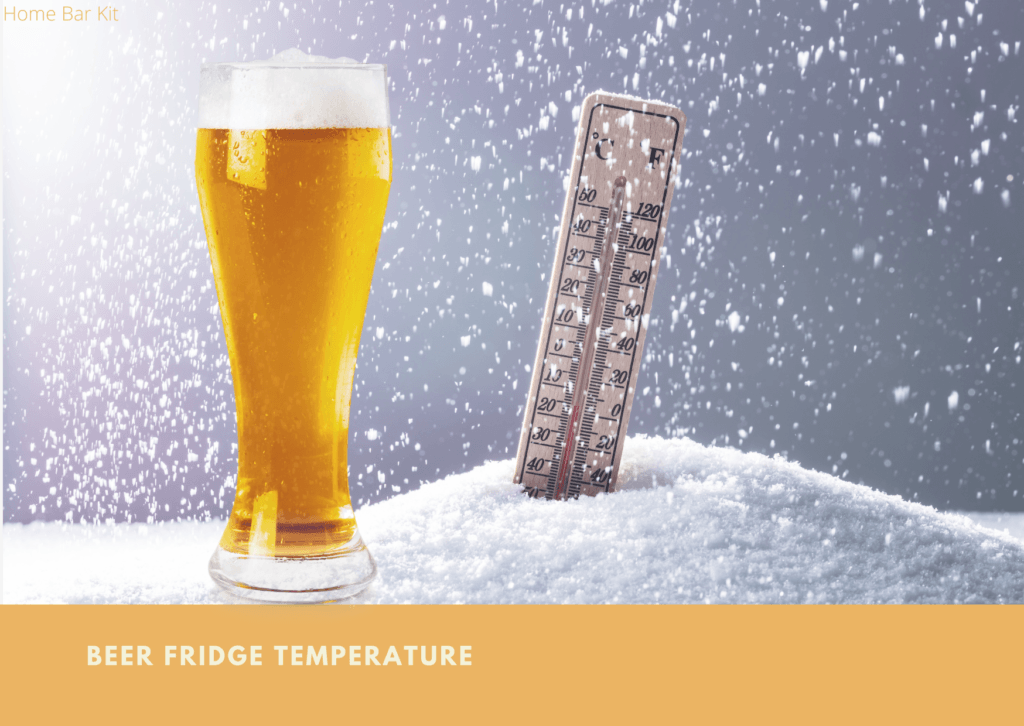
There is no best temperature, it is down to the type of beer you drink, and what you want from that beer. If you always drink macro style beers, then colder is better. On the other hand if you are a stout fanatic, then warmer is better.
The problem arises when like me you like a range of beer styles. Macro for a quick refreshing hit, an IPA for a hoppy flavorsome encounter, or a strong ale to sip and savor.
There are things we can consider to help us store beer for the best consumption experience. But first find out how you like your beer. You may think you like it ice cold, but have you tried it slightly warmer?
I am not talking Light lagers, we know they are best served really cold. How about an IPA, try one at different temperatures. Two cans of the same beer, take one out of the fridge and leave to warm slightly. When it has warmed a bit, pour it into a glass.
Now take the other can straight from the fridge and pour it into another glass. Compare the two, first, take in the aromas, and second, tasting paying attention to flavors and mouthfeel. Let me know if the warmer of the two tasted better.
This will have a bearing on the setting of your fridge temperature.
Where Is The Best Place To Put A Thermometer In A Fridge?
A fridge will register different temperatures depending on where you place your thermometer. Around the door will be the warmest area, especially a fridge with door shelves. The back of the fridge will be colder than the front. Likewise the top shelf of the fridge will be warmer than the bottom.
Therefore, the back of the bottom shelf would be the coldest. And the front of the top shelf by the door would be the warmest. For a food fridge then, the best place would be the middle of the shelf towards the front. This will give a general indication of the overall fridge temperature.
In a beer fridge the same place would work to get the overall temperature to where you want it. However if you want your favorite beer to be at the right temperature. Then place the thermometer where that beer sits, and compromise on the other beers slightly.
An easy rule is to set you macro’s on the bottom shelf, set the fridge to say 38°F (3.3°C) and then place your IPA’s above and your real ales at the top. Once your fridge is stabilized, test the temperature on the respective shelves.
If the temperature is a little low for your stouts, then you know to take them out a little while before you drink them. On the other hand you could get a few thermometers, so you know what each part of the fridge is registering. It depends how particular you want to be with your beer temperatures.
“As an Amazon Associate I earn from qualifying purchases.”
Fridge Thermometers
Like anything these days there are many fridge thermometers to choose from. Which one is the best, remains to be a personal choice. Go for simplicity, or go for digital tech with temperature alarms. As long as it is pretty accurate then it doesn’t really matter.
Camco Fridge Thermometer
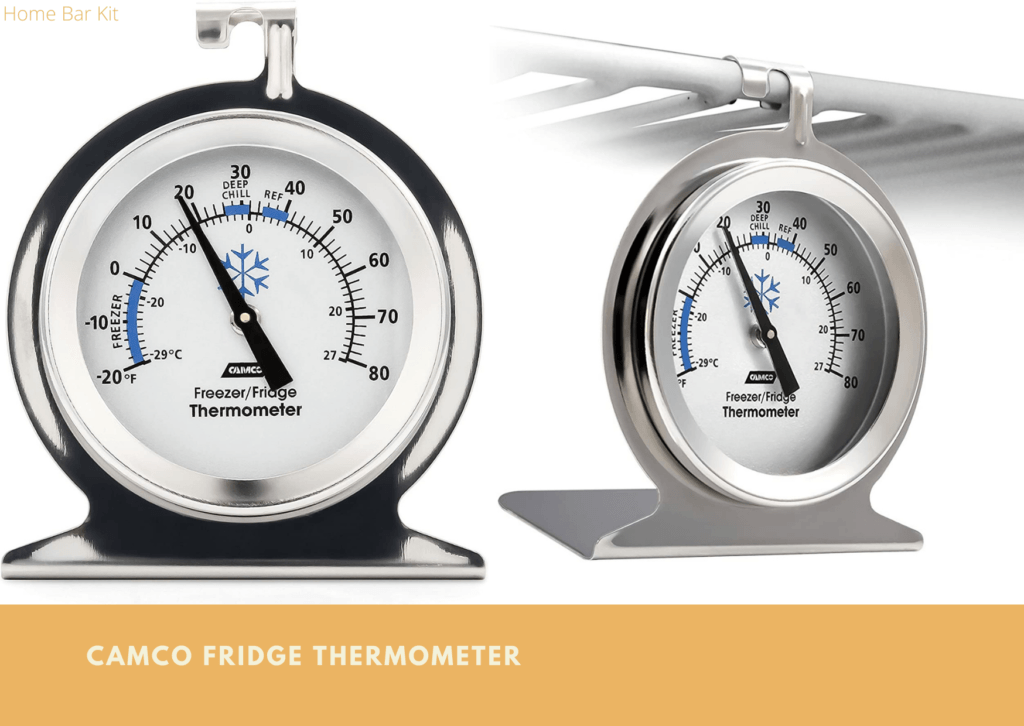
Starting with simplicity, we have a durable stainless steel dial design thermometer. A good temperature range meaning it could be used for a freezer as well as a fridge. An easy to read dial shows both Fahrenheit and Celsius. Ranging from -20°F (-28.8°C) to 80°F (26.6°C), its got flexibility. Best not to serve your beer at either end of this scale.
The Camco is around 3 inches (7.6 cm) in height and can stand on a fridge shelf, or hang from one of the shelf racks. Easy to use and easy on the pocket too.
Digital Fridge Thermometer
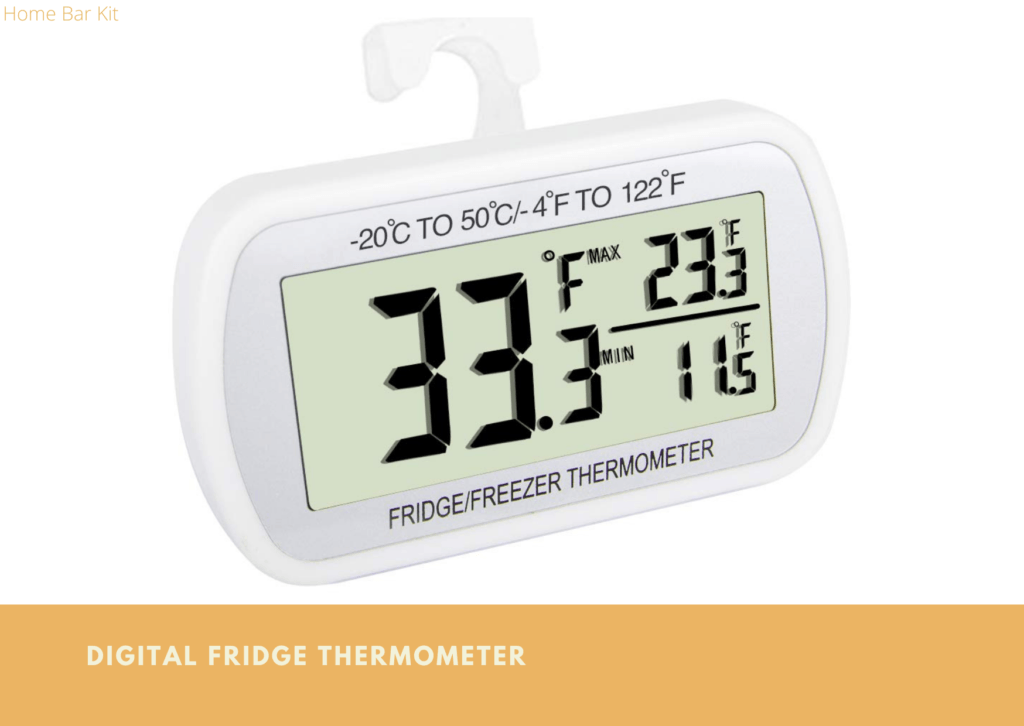
This digital fridge thermometer is compact and neat. Blending into the fridge interior, but displaying a clear temperature readout. It can be set via a switch on the back to register in Fahrenheit or Celsius. The range is from -4°F (-20°C) to 122°F (50°C).
The small unit is 1.7 inches (4.3 cm) high and 3.4 inches (8.6 cm) in width and can stand or hang in the fridge. As it can be used as a room thermometer too, there is a magnet on the back so it can fix to metal surfaces. If you prefer digital, then this is a great little thermometer.
Wireless Fridge Thermometer
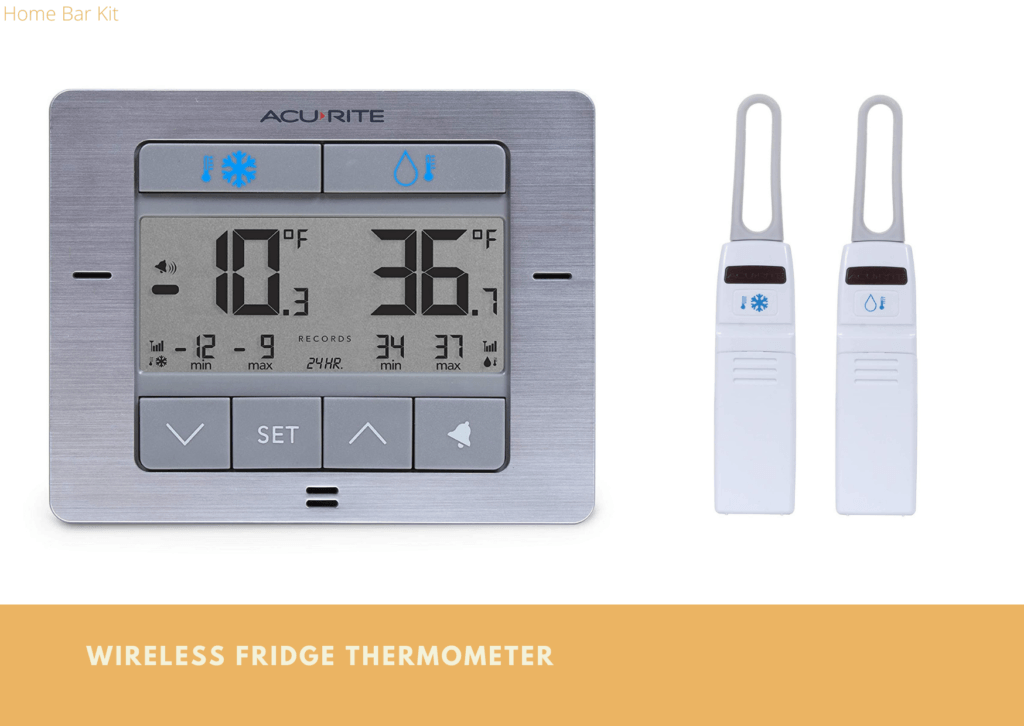
This one is a little more sophisticated with its wireless technology and temperature alarms. For the serious beer temperature monitor, it will not disappoint. It comprises of one display unit and two sensors, one for the fridge and one for the freezer, which communicate wirelessly.
The sensors hang in the fridge from a suction pad provided. The head unit can be fridge mounted using magnets, has a stand for counter top, or can be wall mounted. Each sensor can be programmed with a minimum and maximum temperature. If your fridge temperature spikes because the door was not shut properly, then an alarm will sound. The fire service and police department will be notified, just kidding.
For a more complex way to monitor your beer fridge temperature, then go wireless.
Instant Read Thermometer

Not one for putting in the fridge, but one to check your beer when you pour. If you have a fridge that has a selection of different styles stocked. Then we know it is hard to get a temperature to suit all beers. As I said before, set it to accommodate the beers that need it the coldest.
Beers that need a slightly warmer temperature to be enjoyed can be taken out before you are ready to drink. This is where the instant read thermometer comes in, check the temperature of your beer before you drink.
Similar in the way the fridge monitors work, this has a simple on/off switch. A switch to flick between either Fahrenheit of Celsius. A range of -40°F (-40°C) to 450°F (230°C). These are used for cooking mainly, but can measure temperature in liquid too.
Final Thoughts
In conclusion then it is plain to see that a fridge thermometer that keeps an eye on our beer is a must. But only if you are particular about drinking different beers at the right temperature, or there abouts.
Breweries work hard to bring us good beer that will take our taste buds on a journey of discovery. Why would we conceal those flavors by serving our beer to cold. Raise the temperature people and relish the experience.
Rob is a passionate home bar and pub shed enthusiast with a passion for craft beer. With hands-on experience in designing and building his own home bar, Rob shares his knowledge, tips, and inspiration to help fellow enthusiasts create their own perfect space. Alongside the world of home bars and pub sheds, Rob also explores the diverse and exciting realm of craft beer, providing honest reviews to help you discover your next favorite brew. Join Rob on a journey of flavor, design, and craftsmanship right here on Home Bar Kit.

